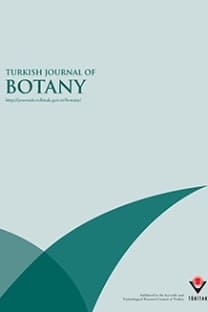Random amplified polymorphic DNA as a method to screen metal-tolerant barley (Hordeum vulgare L.) genotypes
Differentially responding genotypes are comparatively used to understand mechanisms of metal tolerance in higher plants. The feasibility of the random amplified polymorphic DNA (RAPD) technique was evaluated to screen for metal tolerance within plants as an alternative to physiological growth parameters. Eight hydroponically grown barley (Hordeum vulgare L.) genotypes were exposed to different concentrations (75, 150, and 225 μM) of cadmium and copper for 7 days and subsequently harvested for determining metal tolerance indices by comparing dry biomass to genomic template stabilities based on their RAPD profiles. Dose- and genotype-dependent reductions in dry weights of shoot and root tissues were detected for both metal treatments. The tolerance indices showed that Aydanhanım/Bülbül-89 and Başgül/Tarm-92 were the most tolerant/sensitive barley genotypes to cadmium and copper, respectively. For untreated barley genotypes, the amplified RAPD bands were genotype-dependent and estimated genetic similarity coefficients ranged from 0.56 to 0.82. Metal exposure caused appearance and/or disappearance of RAPD bands in comparison to the control RAPD profiles. The alterations in RAPD profiles were dose- and genotype-dependent for the cadmium and copper treatment groups. Consequently, genomic template stability (GTS, %) of all barley genotypes was reduced with metal exposure. Based on GTS values, the most tolerant/sensitive barley genotypes to cadmium and copper were Aydanhanım/Tarm-92 and Avcı-2002/Orza-96, respectively. The growth and RAPD results clearly indicated that Aydanhanım, Avcı-2002, and Başgül were more tolerant, while Bülbül-89, Orza-96, and Tarm-92 were more sensitive barley genotypes to both metals. The RAPD technique could be used to screen metal-tolerant plant genotypes as an alternative method.
Random amplified polymorphic DNA as a method to screen metal-tolerant barley (Hordeum vulgare L.) genotypes
Differentially responding genotypes are comparatively used to understand mechanisms of metal tolerance in higher plants. The feasibility of the random amplified polymorphic DNA (RAPD) technique was evaluated to screen for metal tolerance within plants as an alternative to physiological growth parameters. Eight hydroponically grown barley (Hordeum vulgare L.) genotypes were exposed to different concentrations (75, 150, and 225 μM) of cadmium and copper for 7 days and subsequently harvested for determining metal tolerance indices by comparing dry biomass to genomic template stabilities based on their RAPD profiles. Dose- and genotype-dependent reductions in dry weights of shoot and root tissues were detected for both metal treatments. The tolerance indices showed that Aydanhanım/Bülbül-89 and Başgül/Tarm-92 were the most tolerant/sensitive barley genotypes to cadmium and copper, respectively. For untreated barley genotypes, the amplified RAPD bands were genotype-dependent and estimated genetic similarity coefficients ranged from 0.56 to 0.82. Metal exposure caused appearance and/or disappearance of RAPD bands in comparison to the control RAPD profiles. The alterations in RAPD profiles were dose- and genotype-dependent for the cadmium and copper treatment groups. Consequently, genomic template stability (GTS, %) of all barley genotypes was reduced with metal exposure. Based on GTS values, the most tolerant/sensitive barley genotypes to cadmium and copper were Aydanhanım/Tarm-92 and Avcı-2002/Orza-96, respectively. The growth and RAPD results clearly indicated that Aydanhanım, Avcı-2002, and Başgül were more tolerant, while Bülbül-89, Orza-96, and Tarm-92 were more sensitive barley genotypes to both metals. The RAPD technique could be used to screen metal-tolerant plant genotypes as an alternative method.
